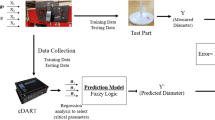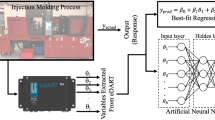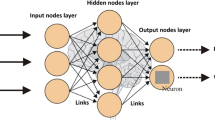Abstract
Dimensional defect is one of critical issues in injection molding. The consistency of processing conditions can affect the dimensional stability of molded parts. In this paper, a systematic approach is proposed to achieve two objectives. The main objective is to predict the diameter of injection molded parts according to real-time processing data. The second objective is to provide on-line insight from process monitoring by utilizing a monitoring system with in-mold sensors. To meet these objectives, artificial neural network (ANN) and multiple linear regression (MLR) were used to build the prediction model that was integrated with the monitoring system. Taguchi experiments were presented in the study for choosing the optimal parameter settings to meet the target diameter of 50 mm. Five controllable parameters in the study include shot size, nozzle temperature, barrel temperature, cooling time, and holding time. With the processing data collected from the sensors embedded in the surface of mold cavity, regression analysis was employed to build and test the relationship between the processing data and the diameter. The real-time variables from the sensor-based monitoring system such as mold temperature and flow rate were selected as the inputs of the predictive model. The feedforward ANN and MLR models were established to predict the outcome based on the data extracted from sensors, with the prediction accuracy of 99.79% and 99.78%, respectively. It would provide a fast measure and good control of dimensional issues in injection molding.








Similar content being viewed by others
References
Huang, Z.M., Kim, H.M., Youn, J.R., Song, Y.S.: Injection molding of carbon fiber composite automotive wheel. Fibers Polym. 20(12), 2665–2671 (2019)
Caltagirone, P.E., Ginder, R.S., Ozcan, S., Li, K., Gay, A.M., Stonecash, J., Steirer, K.X., Cousins, D., Kline, S.P., Maxey, A.T., Stebner, A.P.: Substitution of virgin carbon fiber with low-cost recycled fiber in automotive grade injection molding polyamide 66 for equivalent composite mechanical performance with improved sustainability. Compos. B Eng. 221, 109007 (2021)
Guo, G., Finkenstadt, V.L., Nimmagadda, Y.: Mechanical properties and water absorption behavior of injection-molded wood fiber/carbon fiber high-density polyethylene hybrid composites. Adv. Compos. Hybrid Mater. 2(4), 690–700 (2019)
Guo, G., Kethineni, C.: Direct injection molding of hybrid polypropylene/wood-fiber composites reinforced with glass fiber and carbon fiber. Int. J. Adv. Manuf. Technol. 106(1), 201–209 (2020)
Guo, G., Chen, J.C., Gong, G.: Injection molding of polypropylene hybrid composites reinforced with carbon fiber and wood fiber. Polym. Compos. 39(9), 3329–3335 (2018)
Gong, G., Chen, J.C., Guo, G.: Enhancing tensile strength of injection molded fiber reinforced composites using the Taguchi-based six sigma approach. Int. J. Adv. Manuf. Technol. 91(9), 3385–3393 (2017)
Guo, G.: Investigation on surface roughness of injection molded polypropylene parts with 3D optical metrology. Int. J. Interact. Des. Manuf. (IJIDeM) 16(1), 17–23 (2022)
Abdul, R., Guo, G., Chen, J.C., Yoo, J.J.W.: Shrinkage prediction of injection molded high density polyethylene parts with taguchi/artificial neural network hybrid experimental design. Int. J. Interact. Des. Manuf. (IJIDeM) 14(2), 345–357 (2020)
Guo, G., Li, Y., Zhao, X., Rizvi, R.: Tensile and longitudinal shrinkage behaviors of polylactide/wood-fiber composites via direct injection molding. Polym. Compos. 41(11), 4663–4677 (2020)
Syed, S.F., Chen, J.C., Guo, G.: Optimization of tensile strength and shrinkage of talc-filled polypropylene as a packaging material in injection molding. J. Packag. Technol. Res. 4(1), 69–78 (2020)
Zhao, P., Zhang, J., Dong, Z., Huang, J., Zhou, H., Fu, J., Turng, L.S.: Intelligent injection molding on sensing, optimization, and control. Adv. Polym. Technol. 2020, 7023616 (2020). https://doi.org/10.1155/2020/70236163
Yu, S., Zhang, T., Zhang, Y., Huang, Z., Gao, H., Han, W., Turng, L.S., Zhou, H.: Intelligent setting of process parameters for injection molding based on case-based reasoning of molding features. J. Intell. Manuf. 33(1), 77–89 (2022)
Zhang, Y., Mao, T., Huang, Z., Gao, H., Li, D.: A statistical quality monitoring method for plastic injection molding using machine built-in sensors. Int. J. Adv. Manuf. Technol. 85(9), 2483–2494 (2016)
Zhou, X., Zhang, Y., Mao, T., Zhou, H.: Monitoring and dynamic control of quality stability for injection molding process. J. Mater. Process. Technol. 249, 358–366 (2017)
Yang, Y., Yang, B., Zhu, S., Chen, X.: Online quality optimization of the injection molding process via digital image processing and model-free optimization. J. Mater. Process. Technol. 226, 85–98 (2015)
Guo, F., Zhou, X., Liu, J., Zhang, Y., Li, D., Zhou, H.: A reinforcement learning decision model for online process parameters optimization from offline data in injection molding. Appl. Soft Comput. 85, 105828 (2019)
Zhao, P., Zhou, H., He, Y., Cai, K., Fu, J.: A nondestructive online method for monitoring the injection molding process by collecting and analyzing machine running data. Int. J. Adv. Manuf. Technol. 72(5–8), 765–777 (2014)
Peng, Y., Li, H., Turng, L.S.: Development of a rheo-dielectric sensor for online shear stress measurement during the injection molding process. Polym. Eng. Sci. 50(1), 61–68 (2010)
Chen, J.Y., Yang, K.J., Huang, M.S.: Online quality monitoring of molten resin in injection molding. Int. J. Heat Mass Transf. 122, 681–693 (2018)
Kazmer, D.O., Johnston, S.P., Gao, R.X., Fan, Z.: Feasibility analysis of an in-mold multivariate sensor. Int. Polym. Proc. 26(1), 63–72 (2011)
Johnston, S., McCready, C., Hazen, D., VanDerwalker, D., Kazmer, D.: On-line multivariate optimization of injection molding. Polym. Eng. Sci. 55(12), 2743–2750 (2015)
Johnston, S.P., Kazmer, D.O., Gao, R.X.: Online simulation-based process control for injection molding. Polym. Eng. Sci. 49(12), 2482–2491 (2009)
Gordon, G., Kazmer, D.O., Tang, X., Fan, Z., Gao, R.X.: Quality control using a multivariate injection molding sensor. Int. J. Adv. Manuf. Technol. 78(9–12), 1381–1391 (2015)
Karagöz, İ: An effect of mold surface temperature on final product properties in the injection molding of high-density polyethylene materials. Polym. Bull. 78(5), 2627–2644 (2021)
Chen, J.C., Guo, G., Wang, W.N.: Artificial neural network-based online defect detection system with in-mold temperature and pressure sensors for high precision injection molding. Int. J. Adv. Manuf. Technol. 110(7), 2023–2033 (2020)
Li, Y., Chen, J.C., Ali, W.M.: Process optimization and in-mold sensing enabled dimensional prediction for high precision injection molding. Int. J. Interact. Des. Manuf. (IJIDeM) 16, 997–1013 (2021)
RJG eDART Process Control Software v10 Manual. https://rjginc.com/product/edart-software-v10/ Accessed 14 Aug 2022
Taguchi, G., Chowdhury, S., Wu, Y.: Taguchi’s quality engineering handbook. Wiley, New York (2004)
Zhang, J.Z., Chen, J.C., Kirby, E.D.: Surface roughness optimization in an end-milling operation using the Taguchi design method. J. Mater. Process. Technol. 184(1–3), 233–239 (2007)
Acknowledgements
The authors are grateful to Winzeler Gear for providing the eDART system and supplying the Delrin 511DP acetal resin used in this study. The authors are also grateful to the financial support from Illinois Manufacturing Excellence Center (IMEC). The corresponding author is grateful to the Caterpillar Fellowship from Bradley University.
Author information
Authors and Affiliations
Corresponding author
Ethics declarations
Conflict of interest
All the authors of this paper do not have any conflicts of interest.
Additional information
Publisher's Note
Springer Nature remains neutral with regard to jurisdictional claims in published maps and institutional affiliations.
Rights and permissions
Springer Nature or its licensor (e.g. a society or other partner) holds exclusive rights to this article under a publishing agreement with the author(s) or other rightsholder(s); author self-archiving of the accepted manuscript version of this article is solely governed by the terms of such publishing agreement and applicable law.
About this article
Cite this article
Chen, J.C., Guo, G. & Chang, YH. Intelligent dimensional prediction systems with real-time monitoring sensors for injection molding via statistical regression and artificial neural networks. Int J Interact Des Manuf 17, 1265–1276 (2023). https://doi.org/10.1007/s12008-022-01115-5
Received:
Accepted:
Published:
Issue Date:
DOI: https://doi.org/10.1007/s12008-022-01115-5




